
The Hawaii Theatre is a historic 1922 theatre in downtown Honolulu, Hawaii, located at 1130 Bethel Street, between Hotel and Pauahi Streets, on the edge of Chinatown. It is listed on the State and National Register of Historic Places.

The Stanley Theater at Kennedy Boulevard and Pavonia Avenue is near Journal Square in Jersey City, New Jersey.
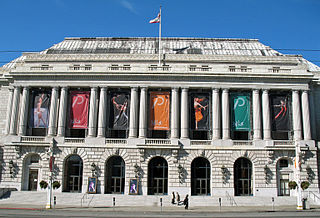
The War Memorial Opera House is an opera house in San Francisco, California, located on the western side of Van Ness Avenue across from the west side/rear facade of the San Francisco City Hall.
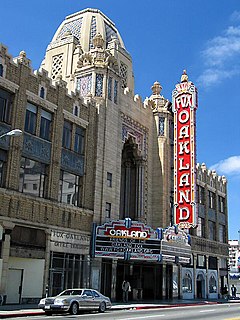
The Fox Oakland Theatre is a 2,800-seat concert hall, a former movie theater, located at 1807 Telegraph Avenue in Downtown Oakland. It originally opened in 1928, running films until 1970. Designed by Weeks and Day, the theatre is listed on the National Register of Historic Places. It was refurbished in the 2000s and reopened as a concert venue on February 5, 2009.

The 5th Avenue Theatre is a landmark theatre building located in Seattle, Washington. It has hosted a variety of theatre productions and motion pictures since it opened in 1926. The building and land is owned by the University of Washington and was once part of the original campus. It is operated as a venue for nationally touring Broadway and original shows by the non-profit 5th Avenue Theatre Association. The theatre, located at 1308 Fifth Avenue in the historic Skinner Building, has been listed on the U.S. National Register of Historic Places since 1978.

The UC Theatre is a music venue on University Avenue near Shattuck Avenue in Downtown Berkeley, Berkeley, California, United States. From 1976 until 2001, it was as a movie theater known for a revival house presentation of films. In 2013, The Berkeley Music Group was formed as a 501(c)(3) nonprofit organization with the mission to renovate and operate the UC Theater as live music venue. It reopened its doors on April 7, 2016.
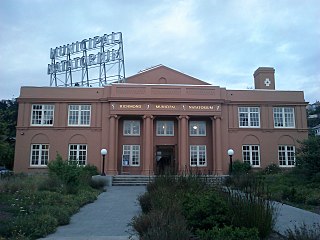
The Richmond Municipal Natatorium, commonly known as The Plunge or The Richmond Plunge, is a historic swim center in the Point Richmond neighborhood of Richmond, California. It was closed in August 2001 for seismic retrofitting and reopened in August 2010. It now is back to a regular schedule.
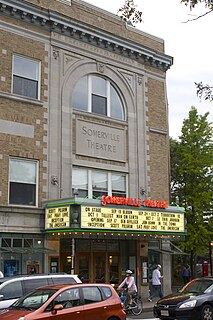
The Somerville Theatre is an independent movie theater and concert venue in the Davis Square neighborhood of Somerville, Massachusetts, United States. Over one hundred years old, the Somerville Theatre started off as a vaudeville house and movie theater. The theater has since transitioned and now operates as a live music venue and first-run movie theater. As a music venue, the theater has played host to many historic concerts, including the first of the two Last Dispatch concerts, two shows by Bruce Springsteen in 2003, and a performance by U2 in 2009. Recent live performances have included Ryan Adams & the Cardinals, Cursive, Norah Jones, The Jonas Brothers, Joan Baez, and the John Butler Trio.

The Fox Tucson Theatre is located in downtown Tucson, Arizona, United States. The theater opened on April 11, 1930 as a performance space in downtown Tucson. It hosts a wide spectrum of events and concerts featuring a variety of performing talent, ranging from ballets, to jazz, contemporary pop, world music and rock acts.

An atmospheric theatre is a type of movie palace design which was popular in the late 1920s. Atmospheric theatres were designed and decorated to evoke the feeling of a particular time and place for patrons, through the use of projectors, architectural elements and ornamentation that evoked a sense of being outdoors. This was intended to make the patron a more active participant in the setting.

The Balboa Theatre is a historic vaudeville/movie theatre in downtown San Diego, US, built in 1924. Listed on the National Register of Historic Places in 1996, the Balboa was refurbished and reopened as a performing arts venue in 2008.
The State Theatre is a single-screen movie theater located in Bay City, Michigan. Built in 1908 during the booming lumbering era in Michigan, the State Theatre was originally known as the Bijou, and was one of the many vaudeville and burlesque houses in Bay City. In 1930 the theater was renovated and reopened as the "Bay". The ownership and the name of the theater changed over the years until July 2000, when the theater was purchased by the Bay City Downtown Development Authority who restored the Mayan motif marquee.

The James R. Browning U.S. Court of Appeals Building is a historic post office and courthouse building located at San Francisco, California. It is a courthouse for the United States Court of Appeals for the Ninth Circuit. Completed in 1905 as the U.S. Courthouse and Post Office, it was intended to represent the affluence and increasing importance of the United States as it became a world power. The building survived both the 1906 San Francisco earthquake and the 1989 Loma Prieta earthquake.

Strand Theatre is a restored vaudeville house located in Uphams Corner in Dorchester, Boston, Massachusetts. It is owned by the City of Boston and managed by the Mayor's Office of Arts and Culture.

Oakland City Hall is the seat of government for the city of Oakland, California. The current building was completed in 1914, and replaced a prior building that stood on what is now Frank H. Ogawa Plaza. Standing at the height of 320 feet (98 m), it was the first high-rise government building in the United States. At the time it was built, it was also the tallest building west of the Mississippi River. The City Hall is depicted on the city seal of Oakland.
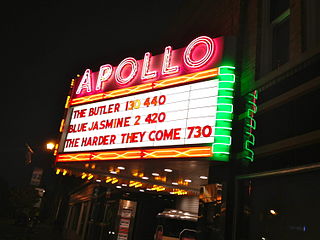
The Apollo Theatre is a 1913 art-deco moviehouse located in Oberlin, Ohio and maintained by Oberlin College. It is notable as one of the earliest theaters to screen "talkies" and for its use as one of Northeast Ohio's film forums.

The Fox Theater is located in Stevens Point, Wisconsin. It was added to the National Register of Historic Places in 1982 for its architectural significance.
The NorShor Theatre is an entertainment venue in downtown Duluth, Minnesota, and was formerly a movie palace and Opera House. It occupies a prominent place along Superior Street, and underwent a massive renovation effort by the City of Duluth. The NorShor played a significant role in the artistic history of Duluth, and is generally considered a landmark.

Michael John Nigel Priestley was a New Zealand earthquake engineer. He made significant contributions to the design and retrofit of concrete structures, and developed the first displacement-based method of seismic design.

The Orpheum Theater, formerly the Sioux Falls Community Playhouse, is a historic theater at 315 North Phillips Avenue in downtown Sioux Falls, South Dakota. It is the oldest theater in Sioux Falls and was listed on the National Register of Historic Places in 1983. Originally, it hosted vaudeville performances, and briefly served as a movie theater before being converted again into a stage theater, which it remains today.
























